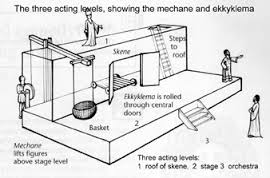Watch children as they play. How many role play being an adult: the brave firefighter, a brilliant doctor, a new mommy? Was there ever a child that didn’t play make-believe? As we grow and mature, our technological society often sends the message that it is wrong to pretend and imagine, so we gradually stop. Imagination and theatre have not been as important in our society as it used to be. In fact, it is often seen as mere entertainment. (Actually, the importance of creativity and imagination is starting to make a come-back as our technology has grown to where mere facts and information no longer need to be engrained in our heads since it is now at our fingertips!!) However, theatre’s foundations evolved not only from pretend and imagination, but from worship and ritual.
WORSHIP OF DIONYSUS
The Greeks used theatre originally in worship celebrations to the god Dionysus. As a polytheistic society, the Greeks believed in many gods. They had a god for almost every aspect of life and many myths and stories to go with them. Dionysus was the god of wine and fertility and his celebrations would come at the harvesting of the grapes. The  Greeks would hold festivals that would last 5-6 days, and a chorus (12-15 people) would chant and dance around an alter where a goat was sacrificed. (Ewww!) Eventually these festivals developed into contests for playwrights. A playwright would submit 3 tragedies and one satyr play. The word tragedy comes from the word TRAGOS, which means “goat song” is a serious play with a protagonist who bravely faces trouble that is caused by his own (or someone else’s) tragic flaw. Eventually, the goat sacrifice was eliminated from the ceremonies, and goats everywhere celebrated! A satyr play was a short comic play that usually made fun of the local leaders that was given at the end so lighten the mood from the heavy tragedies. Ever heard of the word SATIRE?? The winners of the contests would receive the ivy wreath (check out Dionysus!)
Greeks would hold festivals that would last 5-6 days, and a chorus (12-15 people) would chant and dance around an alter where a goat was sacrificed. (Ewww!) Eventually these festivals developed into contests for playwrights. A playwright would submit 3 tragedies and one satyr play. The word tragedy comes from the word TRAGOS, which means “goat song” is a serious play with a protagonist who bravely faces trouble that is caused by his own (or someone else’s) tragic flaw. Eventually, the goat sacrifice was eliminated from the ceremonies, and goats everywhere celebrated! A satyr play was a short comic play that usually made fun of the local leaders that was given at the end so lighten the mood from the heavy tragedies. Ever heard of the word SATIRE?? The winners of the contests would receive the ivy wreath (check out Dionysus!)
ACTORS
Thespis was the very first playwright to win the contest, however, that is not what he is remember mostly for today. In 534 BCE, Thespis stepped away from the chorus and spoke lines on his own, effectively  becoming the very first actor. Performers are called Thespians today and the International Thespian Society is a honorary fraternity for all students in high school theatre! No women were allowed to act in the theatre. In fact, they couldn’t even attend until the 4th century!
becoming the very first actor. Performers are called Thespians today and the International Thespian Society is a honorary fraternity for all students in high school theatre! No women were allowed to act in the theatre. In fact, they couldn’t even attend until the 4th century!  Actors would wear elaborate masks and robes, so that they could play different characters and so that males could be female characters. That’s where we get that universal image of theatre!
Actors would wear elaborate masks and robes, so that they could play different characters and so that males could be female characters. That’s where we get that universal image of theatre!
NOTABLE GREEK PLAYWRIGHTS

Aeschylus (525-456 BC)
– Won 13 1st places, added 2nd actor, known for elevation and mastery of the language, wrote Promethus Bound & Agamemnon
Sophocles (497-405 BC)
– Won 18 1st places, added 3rd actor, known for strong characters, wrote Oedipus Rex, Oedipus at Colonus & Antigone, **MOST FAMOUS**
Euripides (484-406 BC)
– Won 4 1st places, master of Pathos (emotion), began to focus on man and not gods, wrote Media & Trojan Women
Aristophanes (448-380 BC)
– He wrote comedies like The Birds, The Frogs, and The Clouds
AMPHITHEATRES
The theatres were often build on a hillside to conform to nature. Some could fit between 15,000-25,000 people and had fantastic natural acoustics.
Orchestra – large semi-circular area in center where dancing and acting took place
Proskene(parascenia) – the stage
Skene – stone building at back of stage that functioned as scenery and dressing rooms, had 3 entrances
Parados – side entrances for chorus and could tell the audience where characters are going (right=city/port left=fields/abroad)
Theatron – audience seating
SPECIAL EFFECTS
Eccyclema – moveable platform to show effects of violence. The Greeks did not show violence onstage, but did want to see the effects of your actions, so they would bring in a bloody body(ies) on a rolling platform.
WHY GO TO THE THEATRE?





